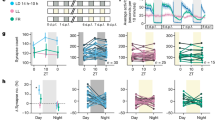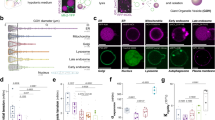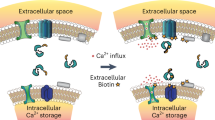Abstract
Activation by agonist binding of G-protein-coupled receptors (GPCRs) controls most signal transduction processes1. Although these receptors span the cell membrane, they are not considered to be voltage sensitive. Recently it was shown that both the activity of GPCRs2,3,4,5 and their affinity towards agonists6 are regulated by membrane potential. However, it remains unclear whether GPCRs intrinsically respond to changes in membrane potential. Here we show that two prototypical GPCRs, the m2 and m1 muscarinic receptors (m2R and m1R), display charge-movement-associated currents analogous to ‘gating currents’ of voltage-gated channels. The gating charge–voltage relationship of m2R correlates well with the voltage dependence of the affinity of the receptor for acetylcholine. The loop that couples m2R and m1R to their G protein has a crucial function in coupling voltage sensing to agonist-binding affinity. Our data strongly indicate that GPCRs serve as sensors for both transmembrane potential and external chemical signals.
This is a preview of subscription content, access via your institution
Access options
Subscribe to this journal
Receive 51 print issues and online access
$199.00 per year
only $3.90 per issue
Buy this article
- Purchase on Springer Link
- Instant access to full article PDF
Prices may be subject to local taxes which are calculated during checkout



Similar content being viewed by others
References
Gether, U. Uncovering molecular mechanisms involved in activation of G protein- coupled receptors. Endocr. Rev. 21, 90–113 (2000)
Marty, A. & Tan, Y. P. The initiation of calcium release following muscarinic stimulation in rat lacrimal glands. J. Physiol. (Lond.) 419, 665–687 (1989)
Ong, B. H. et al. G protein modulation of voltage-sensitive muscarinic receptor signaling in mouse pancreatic acinar cells. Pflügers Arch. 441, 604–610 (2001)
Martinez-Pinna, J., Tolhurst, G., Gurung, I. S., Vandenberg, J. I. & Mahaut-Smith, M. P. Sensitivity limits for voltage control of P2Y receptor-evoked Ca2+ mobilization in the rat megakaryocyte. J. Physiol. (Lond.) 555, 61–70 (2004)
Martinez-Pinna, J. et al. Direct voltage control of signaling via P2Y1 and other Galphaq-coupled receptors. J. Biol. Chem. 280, 1490–1498 (2005)
Ben-Chaim, Y., Tour, O., Dascal, N., Parnas, I. & Parnas, H. The M2 muscarinic G-protein-coupled receptor is voltage-sensitive. J. Biol. Chem. 278, 22482–22491 (2003)
Hodgkin, A. L. & Huxley, A. F. A quantitative description of membrane current and its application to conduction and excitation in nerve. J. Physiol. (Lond.) 117, 500–544 (1952)
Armstrong, C. M. & Bezanilla, F. Currents related to movement of the gating particles of the sodium channels. Nature 242, 459–461 (1973)
Rakowski, R. F. et al. Charge translocation by the Na/K pump. Ann. NY Acad. Sci. 834, 231–243 (1997)
Loo, D. D., Hazama, A., Supplisson, S., Turk, E. & Wright, E. M. Relaxation kinetics of the Na+/glucose cotransporter. Proc. Natl Acad. Sci. USA 90, 5767–5771 (1993)
Murata, Y., Iwasaki, H., Sasaki, M., Inaba, K. & Okamura, Y. Phosphoinositide phosphatase activity coupled to an intrinsic voltage sensor. Nature 435, 1239–1243 (2005)
Stefani, E. & Bezanilla, F. Cut-open oocyte voltage-clamp technique. Methods Enzymol. 293, 300–318 (1998)
Bezanilla, F. & Armstrong, C. M. Inactivation of the sodium channel. I. Sodium current experiments. J. Gen. Physiol. 70, 549–566 (1977)
Haga, K., Haga, T. & Ichiyama, A. Reconstitution of the muscarinic acetylcholine receptor. Guanine nucleotide-sensitive high affinity binding of agonists to purified muscarinic receptors reconstituted with GTP-binding proteins (Gi and Go). J. Biol. Chem. 261, 10133–10140 (1986)
Cohen-Armon, M. & Sokolovsky, M. Evidence for involvement of the voltage-dependent Na+ channel gating in depolarization-induced activation of G-proteins. J. Biol. Chem. 268, 9824–9838 (1993)
Ilouz, N., Branski, L., Parnis, J., Parnas, H. & Linial, M. Depolarization affects the binding properties of muscarinic acetylcholine receptors and their interaction with proteins of the exocytic apparatus. J. Biol. Chem. 274, 29519–29528 (1999)
Kenakin, T. Principles: receptor theory in pharmacology. Trends Pharmacol. Sci. 25, 186–192 (2004)
De Lean, A., Stadel, J. M. & Lefkowitz, R. J. A ternary complex model explains the agonist-specific binding properties of the adenylate cyclase-coupled β-adrenergic receptor. J. Biol. Chem. 255, 7108–7117 (1980)
Lefkowitz, R. J., Cotecchia, S., Samama, P. & Costa, T. Constitutive activity of receptors coupled to guanine nucleotide regulatory proteins. Trends Pharmacol. Sci. 14, 303–307 (1993)
Lechleiter, J. et al. Distinct sequence elements control the specificity of G protein activation by muscarinic acetylcholine receptor subtypes. EMBO J. 9, 4381–4390 (1990)
Wess, J. G-protein-coupled receptors: molecular mechanisms involved in receptor activation and selectivity of G-protein recognition. FASEB J. 11, 346–354 (1997)
Wess, J., Bonner, T. I., Dorje, F. & Brann, M. R. Delineation of muscarinic receptor domains conferring selectivity of coupling to guanine nucleotide-binding proteins and second messengers. Mol. Pharmacol. 38, 517–523 (1990)
Kubo, T. et al. Location of a region of the muscarinic acetylcholine receptor involved in selective effector coupling. FEBS Lett. 241, 119–125 (1988)
Zhu, S. Z., Wang, S. Z., Hu, J. & el-Fakahany, E. E. An arginine residue conserved in most G protein-coupled receptors is essential for the function of the m1 muscarinic receptor. Mol. Pharmacol. 45, 517–523 (1994)
Hulme, E. C., Curtis, C. A., Page, K. M. & Jones, P. G. The role of charge interactions in muscarinic agonist binding, and receptor-response coupling. Life Sci. 56, 891–898 (1995)
Ohana, L., Barchad, O., Parnas, I. & Parnas, H. The metabotropic glutamate G-protein-coupled receptors mGluR3 and mGluR1a are voltage sensitive. J. Biol. Chem. 281, 24204–24215 (2006)
Linden, D. J. Long-term synaptic depression in the mammalian brain. Neuron 12, 457–472 (1994)
Bradley, S. R. et al. Activation of group II metabotropic glutamate receptors inhibits synaptic excitation of the substantia nigra pars peticulata. J. Neurosci. 20, 3085–3094 (2000)
Parnas, H., Segel, L., Dudel, J. & Parnas, I. Autoreceptors, membrane potential and the regulation of transmitter release. Trends Neurosci. 23, 60–68 (2000)
Peleg, S., Varon, D., Ivanina, T., Dessauer, C. W. & Dascal, N. G. αi controls the gating of the G protein-activated K+ channel, GIRK. Neuron 33, 87–99 (2002)
Acknowledgements
We thank T. Kubo for providing us with the clones for the m2R/L3-m1 and m1R/L3-m2 constructs. This work was supported by a grant to J. Dudel, I.P. and H.P. from the Deutsche Forschungsgemeinschaft, and by NIH grants to N.D., B.C. and to F.B.
Author information
Authors and Affiliations
Corresponding author
Ethics declarations
Competing interests
Reprints and permissions information is available at www.nature.com/reprints. The authors declare no competing financial interests.
Supplementary information
Supplementary Notes
This file contains Supplementary Figures 1–8, Supplementary Methods and additional references. (PDF 502 kb)
Rights and permissions
About this article
Cite this article
Ben-Chaim, Y., Chanda, B., Dascal, N. et al. Movement of ‘gating charge’ is coupled to ligand binding in a G-protein-coupled receptor. Nature 444, 106–109 (2006). https://doi.org/10.1038/nature05259
Received:
Accepted:
Published:
Issue Date:
DOI: https://doi.org/10.1038/nature05259
This article is cited by
-
GPCR voltage dependence controls neuronal plasticity and behavior
Nature Communications (2021)
-
Sodium ions allosterically modulate the M2 muscarinic receptor
Scientific Reports (2020)
-
Helix 8 is the essential structural motif of mechanosensitive GPCRs
Nature Communications (2019)
-
Voltage sensing mechanism in skeletal muscle excitation-contraction coupling: coming of age or midlife crisis?
Skeletal Muscle (2018)
-
Proton transfer during class-A GPCR activation: do the CWxP motif and the membrane potential act in concert?
Biophysics Reports (2018)
Comments
By submitting a comment you agree to abide by our Terms and Community Guidelines. If you find something abusive or that does not comply with our terms or guidelines please flag it as inappropriate.



